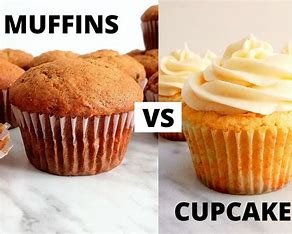Cakes and cupcakes might seem similar since they share many ingredients and the same basic preparation methods, but there are a few key differences between the two. These differences come down to size, texture, presentation, and how they’re served.

1. Size and Portioning:
- Cakes: Typically, cakes are larger and intended to serve multiple people. They come in various shapes and sizes—round, square, or even layered. A cake is usually sliced into portions for serving.
- Cupcakes: Cupcakes are essentially individual servings of cake, baked in small, single-serving sizes, often in a paper or foil liner. They’re designed to be more portable and easy to serve, with each person getting their own.
2. Texture:
- Cakes: Cakes, especially larger ones, tend to have a slightly denser texture, though it can vary depending on the type of cake (like sponge cake or butter cake). The texture is usually soft and moist.
- Cupcakes: Cupcakes have a lighter, more airy texture. Because they are smaller, they often bake more quickly, which can result in a slightly different crumb than a traditional cake. Some people also find cupcakes to be a bit more moist due to their smaller size and higher frosting-to-cake ratio.
3. Baking Time and Method:
- Cakes: Cakes are typically baked in larger pans and can take longer to bake—often 25 minutes or more, depending on size and type.
- Cupcakes: Cupcakes bake faster than cakes because of their smaller size, usually taking around 15 to 20 minutes. The batter is often poured into cupcake liners in a muffin tin.
4. Frosting and Decoration:
- Cakes: While cakes are also decorated with frosting or icing, they often feature larger, more elaborate designs, including layered frosting, fondant, or decorative elements like flowers, cake toppers, or intricate piping.
- Cupcakes: Cupcakes are typically topped with a swirl of frosting (sometimes just a dollop) and are often decorated more simply than cakes. However, because cupcakes are individual, they allow for more fun or themed decoration, often with sprinkles, candies, or other toppings.
5. Serving Style:
- Cakes: Cakes are usually served by slicing, with each person receiving a portion. They are typically served at celebrations like birthdays, weddings, or other large gatherings.
- Cupcakes: Cupcakes are easy to serve at parties, picnics, or casual gatherings. They don’t require slicing, making them more convenient for people to grab and go.
6. Flavor:
- Cakes: Cakes can come in a wide variety of flavors, from classic vanilla and chocolate to more unique options like carrot, red velvet, or fruit-based cakes. They can also have filling layers, such as jam, cream, or custard.
- Cupcakes: Cupcakes also come in various flavors, but since they are individual portions, they often allow for more customization, such as different flavors in one batch (chocolate cupcakes with vanilla frosting, lemon cupcakes with raspberry filling, etc.). Cupcakes often highlight the frosting flavor as much as the cake flavor.
7. Occasions:
- Cakes: Cakes are often the centerpiece of big celebrations and formal events. A wedding cake, birthday cake, or anniversary cake is usually a larger, show-stopping dessert.
- Cupcakes: Cupcakes are perfect for more casual events, like office parties, kids’ parties, or informal gatherings. They also work well as party favors or individually packaged treats.
Conclusion:
While cakes and cupcakes are both delicious treats, the main differences lie in their size, texture, baking process, and how they’re decorated and served. Cakes are larger, often more elaborate, and sliced into portions, whereas cupcakes are smaller, portable, and served individually with an emphasis on frosting decoration. Both are great for different occasions, depending on the formality and style of the event.
